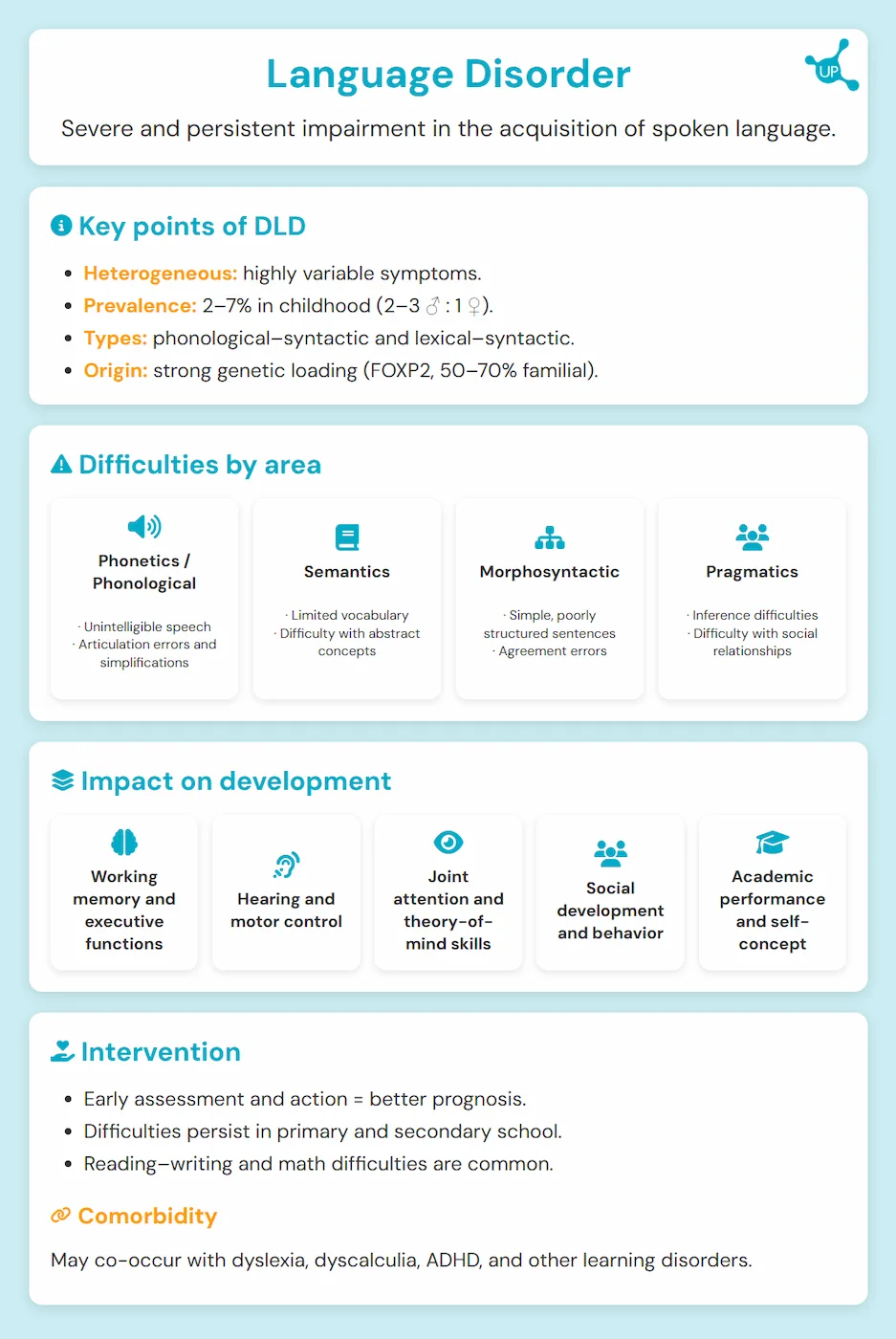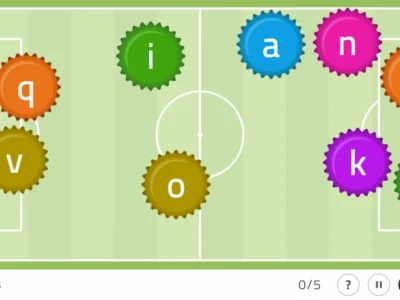Language Disorder (TEL) is a severe, long-lasting neurodevelopmental disorder that affects the acquisition and development of oral language. In addition, it can affect the receptive area, the expressive area, or both.
It is described as a “heterogeneous” disorder because we will never find two identical cases of TEL. This means that the symptoms vary greatly from one child to another and do not always present in the same form or intensity.
Likewise, the language disorder may involve one or several components of language: phonetic and phonological, semantic, morphosyntactic and/or pragmatic.
In this post, Cristina Martínez Carrero from the D-letras center explains the causes, the symptoms and its comorbidity, as well as its diagnosis and intervention.
Specific difficulties by area
Phonetic / phonological area
In the phonetic / phonological area we usually find children with unintelligible speech, many phonological simplification errors, multiple articulatory disorders, and difficulties in auditory discrimination.
Semantic area
In the semantic area, we find children with a reduced vocabulary, difficulties accessing the lexicon, they know the words but have trouble retrieving them. For this reason they often use very general words and circumlocutions. They also have great difficulties expressing and understanding anything abstract, that is, anything that cannot be contextualized. In addition, they find it very hard to learn new vocabulary.
Morphosyntactic area
The morphosyntactic area is the most affected: they tend to use simple sentences with few elements, generally poorly structured with agreement errors, incorrectly conjugated verbs, omissions of prepositions, pronouns, among other errors. Certainly, if the morphosyntactic area is not affected we cannot speak of TEL.
Pragmatic area
The pragmatic area is always affected in people with TEL. They have difficulty establishing social relationships through play, as well as understanding and respecting rules. In addition, they show a difficulty understanding emotional states and resolving interpersonal problems. This represents a major obstacle for making inferences, that is, understanding anything that is not literal and/or contextualized such as irony, double meanings, metaphors, jokes, etc. All of this significantly shapes the way they relate to others.
All the difficulties mentioned cannot be attributed to or associated with any other disorder or pathology; therefore, causes such as hearing loss, brain damage, low intellectual quotient, motor deficit, socio-environmental factors or developmental disorders are ruled out (Leonard,1998).
Areas of development affected by language disorder
TEL is a relatively young term that has undergone many changes in its denomination in a short time, the best known being “dysphasia”. Currently, with the new DSM-V classification it loses the qualifier “Specific Language Impairment, SLI” and opts for “Language Disorders”, leaving for us the term “Language Disorder”, which is placed within the category “Communication Disorders”.
The TEL is further subdivided into two types. On the one hand, there is the phonological-syntactic type, while on the other hand we find the lexical-syntactic.
There is still no clear consensus among the expert committee about which terminology is most appropriate for TEL. However, many seem to agree that “specific” is somewhat incongruous, since although the main impairment in children with TEL is the language dimension, it affects many other areas of development, such as:
- Working memory
- Mentalizing skills
- Hearing
- Executive Functions
- Motor control
- Joint attention
- Social development
- Behavior
- Academic performance
- Self-concept
Causes of language disorder
The causes that produce the disorder are still unknown, but recent studies corroborate the importance of the genetic contribution; between 50 and 70% of children with TEL have at least one family member with the same disorder. In addition, alterations in the FOXP2 gene, known as the language gene, have been found.
Symptoms of language disorder
The prevalence of TEL is 2-7% of the child population with a ratio of 2:1/3:1 for males. It is a serious and persistent disorder that affects language acquisition from its beginnings, persists through childhood and adolescence, and can leave significant sequelae in adulthood. Therefore, early detection and intervention are of vital importance.
One should pay attention to certain warning signs as soon as they are perceived. Let’s avoid some myths and legends such as “they will speak eventually”, “they are very young”, “every child has their own pace”… TEL always appears as a delay in language acquisition. This does not mean that all late talkers will end up having a specific language disorder, but, however, all TEL cases were late talkers.
They often begin to speak later, and generally their vocabulary repertoire is very limited.
- If by 2 years they do not have at least 50 words in their lexical store and of those 50 words 20% are verbs, we have a strong indicator of TEL. Likewise, children at this age who do not combine two words.
- By 3 years they may speak, but present unintelligible speech, sentences with phonetic and phonological errors, and phrases of three elements. Difficulties understanding question-type sentences (what, how, who…).
- If by 4 years they use only phrases of 3 words or less, do not use adjectives or pronouns, have a limited lexicon, and do not produce narratives.
- By 5 years, they produce grammatically incorrect sentences and have difficulty retrieving words when narrating…
Attention! These are warning signs that may indicate possible language difficulties. A child meeting any of them does not necessarily imply a diagnosis of TEL.

Diagnosis and intervention for children with TEL
Early evaluation, diagnosis and intervention are essential in the course of children with TEL.
On the one hand, diagnosis is very complex and poses many problems, especially at early ages.
- Before age 3 it is difficult to determine whether oral language difficulties are due to a language delay or to a language disorder.
- By age 4 a possible TEL can be identified.
- By age 5 the diagnosis is usually confirmed.
We should not wait to confirm a diagnosis, but rather attend to the signs from the moment they are detected. Remember the great impact this disorder has on their school, personal and emotional life, not only in early ages.
When they move on to primary education they compensate for these difficulties; we could say that the symptomatology becomes less evident or visible, especially in the 2nd and 3rd cycles of primary school. They manage to communicate with a more formal and elaborated language, which may lead to the mistaken idea that they have overcome their language difficulties. But this is not the case: they will continue to have difficulties with vocabulary, their expressive language is altered, they have difficulty producing narratives and maintaining a coherent discourse with well-cohesive ideas. They tell shorter stories with fewer main and secondary ideas, poorly temporally sequenced…
In addition, they all tend to present learning problems, especially in the development of reading and writing, as well as the learning of mathematics due to problems in understanding and acquiring more abstract contents. Their academic performance is affected at all stages, including secondary education.
Comorbidity of language disorder
Many TEL cases present comorbidity with other disorders such as dyslexia, dyscalculia, dysgraphia, attention deficit hyperactivity disorder, impairments in social interaction, among others.
Language disorder is considered a special educational need. If there is a large curricular gap (1.5-2 years) they may have significant curricular adaptations.
If after reading this article you have doubts, consult a specialist with experience who can guide and advise you. At d-letras we will be happy to assist you.

If you enjoyed this article about language disorder, you may also be interested in other articles related to language:
“This article has been translated. Link to the original article in Spanish:”
Trastorno del lenguaje: causas, síntomas y comorbilidad







 10 Tips to Improve Memory and Cognitive Health
10 Tips to Improve Memory and Cognitive Health
Leave a Reply